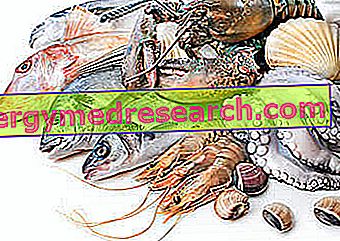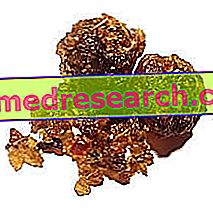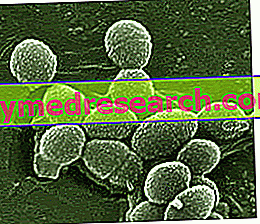Introduction
Definition of "fish"
That of fish is a biological superclass of cold-blooded, aquatic vertebrate animals and gills for underwater breathing.
The group of fish properly so called does not include crustaceans, molluscs and marine mammals.
Fish or fishery products?

Fishery products is a fairly "foreign" wording to common verb and jargon; in fact, from the strictly homemade and "food" gastronomic point of view, with "fish" we refer to the edible part of aquatic animals in general (identifying not only the fish itself, but all the others as well).
Let's look at them in more detail.
Fishery Products
Fish proper
The fish itself is said to populate the salt water, sweet or both.
Most common saltwater fish
The most common saltwater fish on Italian tables are: sole, anchovy, sardine, mackerel, mullet, sea bass, sea bream, tuna, red mullet, scorpion fish, gurnard etc.
Most common freshwater fish
The most consumed freshwater fish at a national level are: trout, whitefish, pike, tench, carp, catfish, perch etc.
Most common fresh and salt water fish
The so-called diadromous fish, that is to say that they live both in fresh and salt water (often migratory, for reasons of reproduction) more known (also worldwide) are: salmon, eel, some mullet, sturgeon, cheppia etc.
Then there are some fish that live very well in brackish water, such as bream, sea bass, mullet, flounder, pagan, etc.
NB . While the salmon is a fish that lives mainly in salt water and then reproduces in fresh water, the life cycle of the eel is diametrically opposite.
Clams
Molluscs can be divided into lamellibranchs, cephalopods and gastropods.
Lamellibranch molluscs or "shell molluscs"
The best known are: mussels (mussels), clams, razor clams, cockles, cockles, sea truffles, oysters etc.
Cephalopod molluscs or "shellless molluscs"
The most marketed are: cuttlefish, octopus, octopus, octopus, squid, squid, etc.
Mollusks Gasteropodi or "snails"
These are sea and land snails, abalone (sea ears) etc.
Crustaceans
Crustaceans can be divided into macro-decapods, brachiuri and stomatopods.
Macruri decapods
The most fished are: prawns and shrimp, prawns, lobsters, lobsters etc.
Brachiuri decapods
This group includes crabs, crabs, spider crabs etc.
Stomatopod decapods
This set is basically represented by the shrimp.
GENERAL FOCUS ON FISH
Fish: Classification and Structure Fish Nutritional Tables Fish Oil Cod Liver Oil Toxins in Fish Meat or Fish? Blue FishMercury in FishFish and Health: Which Fish to Prefer? Fresh Fish and Its ConservationFish FishFish FishSea Fish Fresh Fish from the Battered or Frozen oneInsights on the various species of fish
Fish, Molluscs, CrustaceansAnchures or Anchovies Needlefish Eel Lobster Herring Lobster Herring Lobster Bottarga Sea Bass (Sea Bass) Squid Squid Scallops Canestrelli (Sea Scallops) Capitone Caviar Mullet Fish Monkfish (Monkfish) Mussels Crustaceans Sea Dishes Fish Mussels Shellfish Seafood fish Shrimps Crabs Granseola (Granceola) Halibut Seafood salad Lanzardo Leccia Sea snails Shrimp Cod Mollusks Moscardini Hake Ombrina Oysters Sea bream Palamata Pangasius Paranza Fish Fresh from the season Blue fish Puffer Perch Swordfish Plaice Octopus (Piovra) Sea urchin Amberjack Salmon Sardines Sardines Scampi Cuttlefish Mackerel Sole Dried stockfish Surimi Sushi Telline Tuna Canned tuna Mullet trout Fish roe Clams OTHER FISH ARTICLESFish in the Diet
Comparison of the main chemical and nutritional differences between fishery products.
| Humidity % | Protein% | Lipids% | Sugars% | Ashes% | |
| Pisces | 60-84 | 15-27 | 0.1-30 | Traces | 0.8-2.0 |
| Crustaceans | 70-82 | 13-24 | 0.5-1.5 | 0.3-1.3 | 1.0-4.0 |
| Clams | 78-82 | 11-18 | 1.0-2.5 | 1.6-6.0 | 1.0-3.5 |
For technical and informative correctness, we will document here only the aspects inherent to the "proper fish" category, postponing the reading of what concerns molluscs and crustaceans to the specific articles on the site.
Kitchen
Fish as a food
For humans, fish is a very important food resource, both from a gastronomic point of view and for its important nutritional value. It is therefore logical to think that the relative culinary preparations are "as many ... as there are species and methods of preparation in relation to the species of edible fish". ... but how do you eat a fish?

Video Site
Fish First
Fish seconds
portioning
How much fish each?
The gastronomic classification of the fish follows that of its structural characteristics (see article: Pisces - classification and structure), taking into consideration the dimensions of the raw material to be processed.
Portioning of large fish
The large tapered fish, "normally" undergo the division into smaller pieces called:
- Trance, thickness of 2-3 centimeters (cm) for a weight of 180 grams (g) approx
- Darne, 5-6 cm thick for a weight of 280-350g
- Tails (indicating the caudal portion) of about 250g.
Portioning of medium-small fish

The procedures for dilating and filling fish are more difficult and rarely applied.
Serving of flat fish
Flatfish, those that live on the seabed (sole, turbot, monkfish, dab, breed, etc.) are used both whole and filleted, but in the latter case, from each fish at least 4 fillets are obtained (two per side) .
Meat of the country
Color of fish meat
The meat of the fish, unlike the meat of terrestrial animals, is white or pinkish due to the scarcity of myoglobin (a protein that stores oxygen in muscle tissue); obviously, the fishes that make long migrations or are particularly fast in swimming possess more blood and a more reddish meat, like tuna, bonito, amberjack etc.
On the other hand, other fish such as salmon trout, salmon, char, etc. they have a pink or orange flesh that has nothing to do with the concentration of myoglobin; they have a very high content of crustaceans, which (feeding on a particular alga) are red (thanks to the high concentration of astaxanthin, a carotenoid provitamin with a very high antioxidant power which, following the food chain, reaches the meat some fish).

Connective and fat in fish flesh
Fish is also a highly digestible food; this characteristic is attributable to 2 well-known properties:
- Low lipid concentration, although there is some heterogeneity between the species
- Low concentration of connective tissue and sarcoplasmic proteins, which allows a reduced gastric permanence and becomes particularly evident in the flaking of the meat after cooking.
Some examples:
| CLASIFICATION FOR FISH DIGITALIBILITY | |
| Very digestible | Cod, hake, trout, sole, sea bass, sea bream etc. |
| Digestible | bream, tench, sardine, swordfish etc. |
| Not easily digestible | tuna, eel, mackerel, herring etc. |
Fish is also a high protein food and contains all the essential amino acids in satisfactory quantities. However, the peptide concentration is not the same among the various species present on the market; in this sense, we can distinguish the fish properly called in the following way:
| CLASIFICATION FOR FISH PROTEIN CONTENT | |
| % protein on 100g of edible portion | Fish species |
| <16% | eel, mullet, bream, sole, mullet etc. |
| 17%: 19% | anchovy, red snapper, pike, cod, hake, sardine, sea bass etc. |
| > 19% | sea bream, mackerel, tuna, swordfish etc. |
For what concerns the lipid content instead, the fish is classified further:
| CLASIFICATION FOR LIPID CONTENT OF FISH | ||
| Name | % of lipids on 100g of edible portion | Fish species |
| Lean fishes | <1% | Cod, hake, sea bream, breed, tench, etc. |
| Lean fish | 1%: 3% | Carp, snapper, pike, dogfish, turbot, redfish, sole, sea bass, trout etc. |
| Semi-fat fish | 3%: 10% | Anchovy, mullet, swordfish, bream, sardines, mullet, etc. |
| Fatty fish | 10%: 14% or more | Eel, salmon, mackerel, tuna, etc. |
Nutrition
Nutritional characteristics of fish
Water in fish
Water is present in fish in quantities ranging from 60 to 80% and, generally, it is inversely proportional to the lipid percentage: greater fat is equivalent to less water in the meat.
Protein in fish
From 15% to 25%; they are of high biological value (similar to that of meat, inferior only to egg or milk serum proteins) and particularly rich in the amino acids histidine, lysine and arginine; methionine is the limiting amino acid.
Compared to meat, there are more myofibrillar proteins (actin and myosin) and less sarcoplasmic proteins (elastin, collagen) and globulins (myoglobin and hemoglobin).
Lipids in fish
From 0.5% to 22%; in general, the more the fish is thin and the more fat its liver is and vice versa; fish oil, for example, is often made from cod liver, which lives in the northern seas and has particularly lean meats.
In fish both cholesterol and saturated, monounsaturated and polyunsaturated fatty acids are present; the most interesting aspect of the fish is that, above all in the fish of the cold seas of the North and in the blue fish, the concentration of polyunsaturated fatty acids (PUFA) and relative essential fatty acids ω3 (AGE-ω3) is particularly high; moreover, the ω3 of the fish consist predominantly of eicosapentaenoic acid or EPA (20: 5) and docosahexaenoic acid or DHA (22: 6), metabolically more active forms of alpha-linolenic acid typical of vegetables.
AGE-ω3 are particularly useful in contrasting cardiovascular diseases, positively affecting the balance of blood lipids and thus preventing the formation of atherosclerotic plaques in the arteries.
Note : by virtue of its high PUFA content, fish fat has a lower consistency (less hard, always viscous but more liquid) than that of meat (compact), and with respect to the latter peroxidum deteriorates more rapidly.
The fish also has a lower cholesterol content than meat and, although its concentration varies greatly from one species to another (excluding crustaceans that are not fish, and fish eggs that are not fish meat), on average it is of small entity.
At the same time, the fish is characterized by the high content of phospholipids and lecithins, substances with a good emulsifying power which increases the digestibility of the food itself; moreover, at the intestinal and metabolic level, lecithins have the power to reduce cholesterol absorption and facilitate removal from the arteries.
The concentration of essential fatty acids ω3 type EPA and DHA, associated with the low cholesterol content and the good intake of lecithins, gives the fish the characteristic of HYPOCOLESTEROLEMIZING and PREVENTIVE food towards CARDIOVASCULAR pathologies of atherosclerotic nature.
Fish carbs
In fish we find traces of glucose, fructose and glycogen; similar to meat, carbohydrates decay rapidly after the death of the animal, as anaerobic metabolism remains in the cells which rapidly depletes the substrate, producing lactic acid.
Fish vitamins
The fat-soluble ones are mainly contained in the liver and in fish oils (Vitamin A and D), while the water-soluble ones (B2, B6) are present in the muscles; vitamin C is absent
Mineral salts of fish
From 0.8% to 2%; they are present in greater concentrations in sea fish than the others, where we find good quantities of iodine, sodium (for this reason its meats are tastier than those of freshwater fish), but also calcium and phosphorus.
Other information
Inadequate consumption and hygiene risks
Despite the fact that the fish, due to its nutritional characteristics to say the least, is a food that should be increased per capita consumption, there are some aspects that should be taken into account. First, inadequate consumption of fish, like that of many other foods, puts consumers at risk of hygienic nature. Inadequate consumption means:
- Consumption of raw fish NOT thermally cut, which increases the risk of parasitosis
- Excessive consumption of large swimmer fish, which contain high amounts of pollutants such as industrial or agricultural discharges and related chemical pollutants, mercury, etc.
- Excessive consumption of large-sized bottom fish, which contain high quantities of pollutants, above all type sewer drains caught and trawling, which facilitates the increase of the microbial load.
It is therefore essential that, in addition to lowering the temperature (which favors the death of Anisakis-type pests), especially for bottom fish, cooking is used, which destroys the bacterial load and facilitates the catabolism of many toxic substances.
Notes on fish contaminants
fish contaminants derive mainly from the environment in which they live; can be divided into:
- Chemical contaminants:
- Heavy metals (lead, cadmium, mercury)
- Pesticides
- Organic chlorine and bromine compounds
- Biological contaminants:
- Toxins produced by algae and some fish species, such as puffer fish, can cause: poisoning with PSP paralysis; neurotoxic poisoning NSP; amnesic poisoning ASP; Diarrheal DSP poisoning
- Parasites and microorganisms (they are more common in farmed fish, except for the widely distributed Anisakis in open water).
Ecosustainability of fishing
A further observation must be made regarding the eco-sustainability of fisheries and farms; not all withdrawals and farms are environmentally sustainable, as some significantly affect the density of the wild fish population.
All sources of sampling based on: intensive techniques, with thin-mesh nets (which also take juvenile fish), all types of trawl (which devastate the seabed and broods during reproduction) would be excluded, clams by turbines (which also destroy the broods), etc., but also those farms which, in order to be maintained, rely on the harvesting of other marine species (krill type for the salmon).
A similar market should not be encouraged by consumers but weakened, even if today users themselves do not have the tools and information necessary to evaluate the sustainability of fisheries and livestock.



